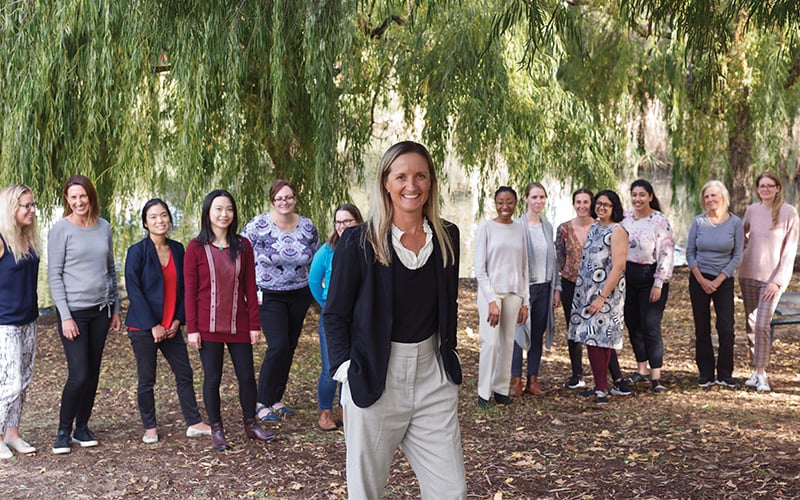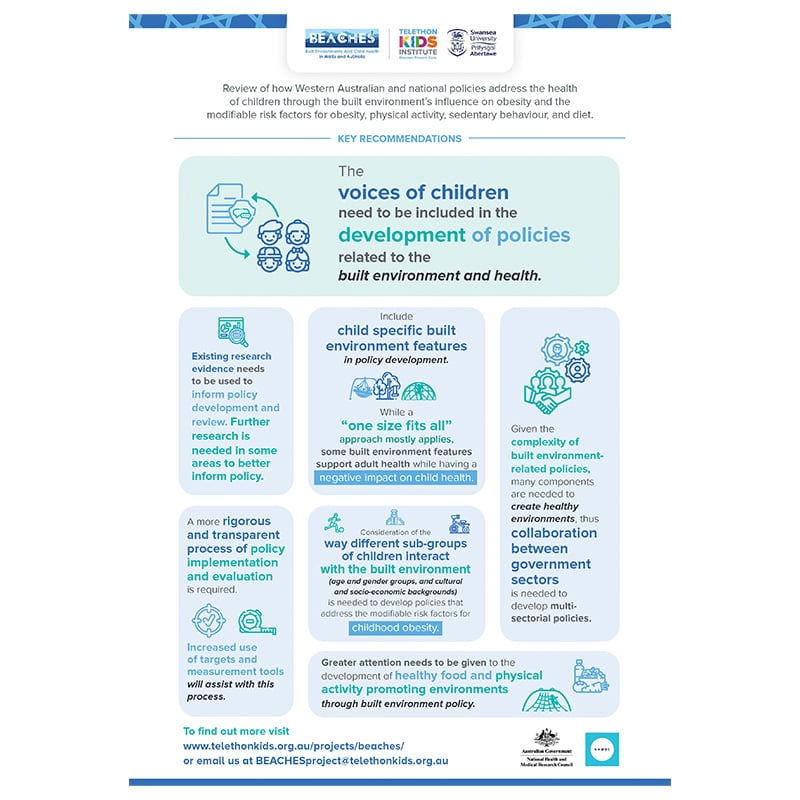
Associate Professor Hayley Christian, sixth from left, and members of the Child Physical Activity, Health and Development team
When a safe, affluent country like Australia scores a D-minus for children’s physical activity and manages to rank only 30th amongst the world’s richest countries for the kind of environment it provides for kids, it’s clear some kind of reset is needed. The Kids Research Institute Australia researchers are working to reverse these trends from the ground up – starting with urging governments to listen more to what kids need.
In May this year UNICEF’s Office of Research released its Innocenti Report Card 17, Places and Spaces: Environments and children’s wellbeing.
The report focused on how well 43 OECD countries are doing at providing healthy, safe, sustainable environments for children’s development, health and wellbeing.
Along with water and air quality, overcrowding, whether a child has a healthy home, and how a country’s environmental actions affect children beyond their own borders, the report examined how easy it is for children to access green play spaces, safe from road traffic.
Australia came in at a lowly 30th position overall on the league table, trailing countries like the Czech Republic, Estonia, and Malta.
Although much of Australia’s poor ranking is undoubtedly due to its lacklustre climate change policies, harsh judgments of the environment Australia provides for its children weren’t a huge surprise to Associate Professor Hayley Christian, who leads the Child Physical Activity, Health and Development team at The Kids Research Institute Australia.
She recently completed the BEACHES policy review – a comprehensive report examining the impact on children’s health and wellbeing, including physical activity levels, of dozens of built environment-related policies across Australia.
The report, launched in February and created with partners including the Western Australian Department of Transport, showed one thing was clearly missing when it came to developing built environment policy in Australia: the voices of children.
“Our number one finding after examining more than 40 planning and transport policies across the country was that children’s voices must be included in the development of policy,” Associate Professor Christian said.
“Many of our policies are still dominated by the desire to make the motor vehicle commute as short as possible, rather than thinking about the bigger picture.
“If we aren’t paying attention to how these kinds of decisions are likely to affect families and children, then we can hardly be surprised when we end up with built environments that stop kids from being able to enjoy the outdoors, engage in physical activity, and walk or ride to school safely.”
In further sobering evidence of how much work remains to be done to improve physical activity levels in Australian children, the Asia-Pacific Society for Physical Activity (ASPA) this year delivered its latest report cards on the performance of eight countries in the Asia-Pacific region.
In findings partly informed by data from the PLAY Spaces and Environments for Children’s Physical Activity, Health & Development (PLAYCE) study – also led by Associate Professor Christian – Australia scored a D-minus for children’s overall physical activity.
“Only 20 per cent of WA kids now ride or walk to school, compared to 75 per cent a few decades ago, and only a third of Australian children aged 2–5 get the recommended amount of physical activity,” Associate Professor Christian said.
“We have to do more to create safe routes to school, and to improve physical activity levels in children from the earliest possible ages.”
As well as calling for child impact assessments to be undertaken before any new policy decisions are made, the BEACHES report recommended
policy development be more evidence informed, with more cross-sector collaboration.
Policies should also include child-specific built environment features, and consider how built environment policy impacts different subgroups of children (including different age groups and different cultural and socio-economic backgrounds).
We know a lot about what works to get kids moving more, but the existing research evidence about this needs to be translated into policies and actions,” Associate Professor Christian said. “As part of that process, it is imperative governments hear from children and families.
Encouragingly, WA Transport and Planning Minister Rita Saffioti agrees.
Associate Professor Christian, together with The Kids Director Professor Jonathan Carapetis and Government Relations Advisor Fiona Roche, met with the Minister before the report’s launch.

BEACHES policy review
“The Minister really resonated with the key finding about children’s voices being included in the development of policies,” Associate Professor Christian said.
“We’ve since met with Department of Transport representatives and other state and local government departments. I have also presented to a WA working group involving a number of organisations and government departments about promoting active school transport.”
In other Institute efforts to improve Australia’s performance when it comes to the built environment, Associate Professor Christian was last year part of the technical working group responsible for national research priority setting in the area of active transport.
In work funded by VicHealth, the group published a paper in the Journal of Transport and Health laying out the key research questions that will help to advance active transport – such as walking and bike riding – in Australia.
In addition, the Institute endorsed ASPA’s Three Transport Priorities document, delivered to federal politicians ahead of the recent federal election and calling for lower default urban speed limits in residential areas including school zones, 1500m safe routes to school, and e-bike subsidies.
